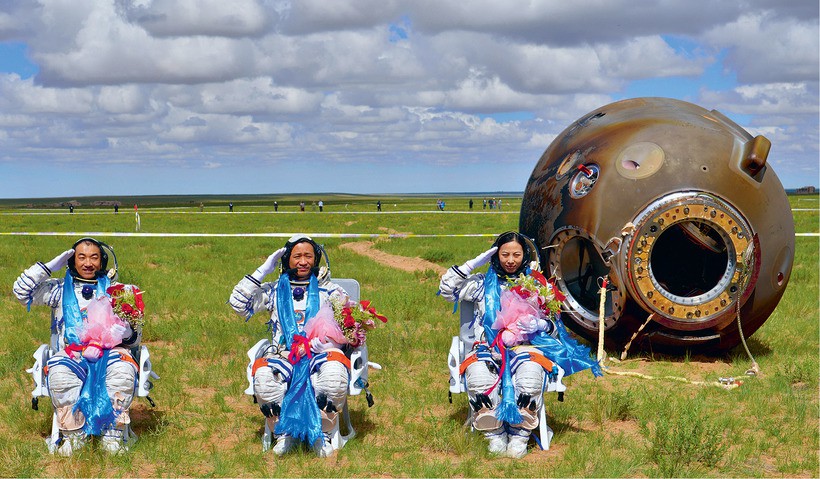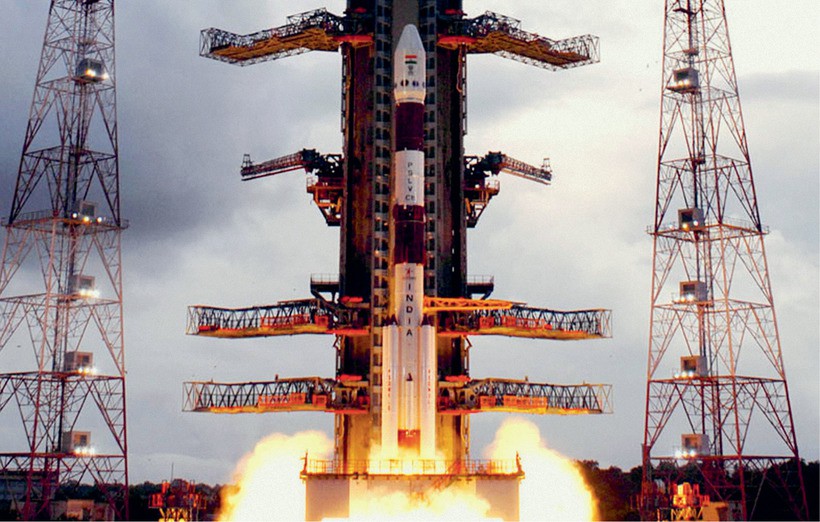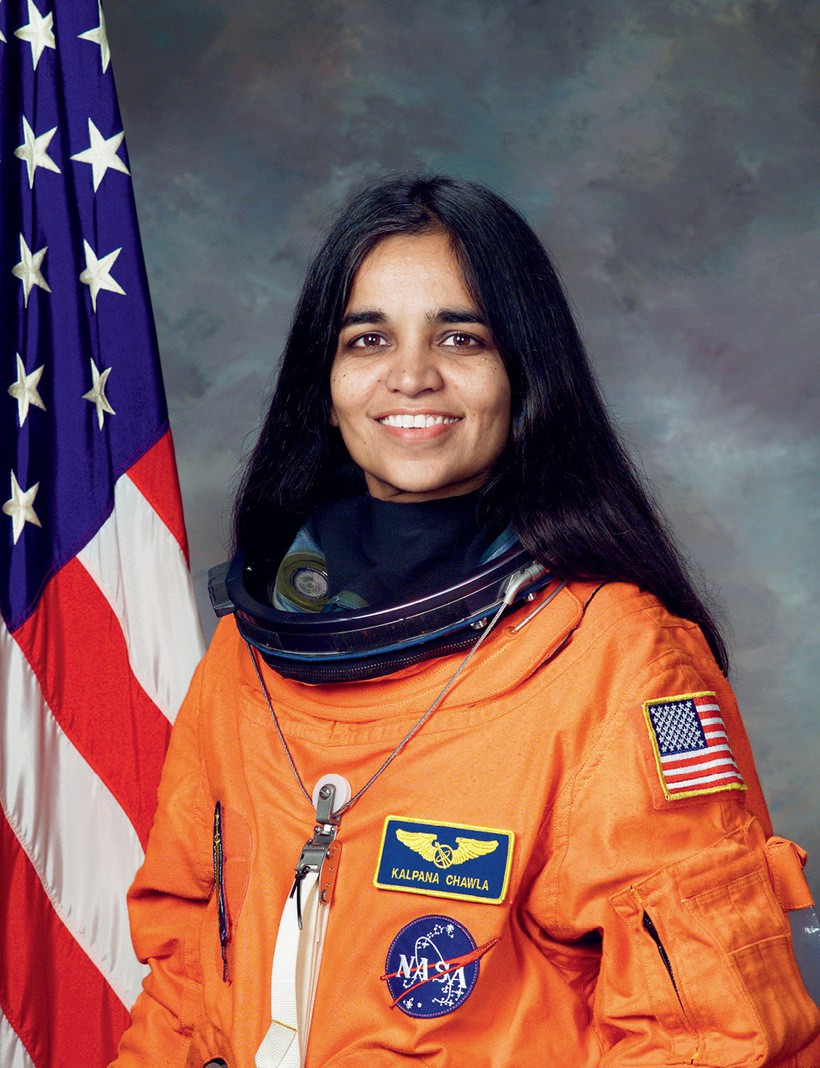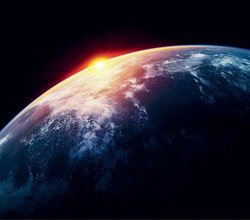The Dragon vs. the Elephant
An orbital encounter
India and China - the two perennial rivals vying for leadership in Asia, and perhaps the world – have always been jealous of each other’s successes. Today, the rivalry between the two ambitious Asian superpowers has moved into space, where New Delhi and Beijing have no intention of giving each other any ground.
Evgeniy Pakhomov
It is hard to imagine now that New Delhi and Beijing were once considered good friends, and even spoke amiably of a close partnership. In 1951, India turned a blind eye to the Chinese army’s takeover of Tibet and limited its reaction to formal statements – bilateral relations seemed to be more important to New Delhi. The famous slogan, Hindi-Chini bhai-bhai! (Indians and Chinese are brothers!), that remained popular for many years first appeared during that period. However, the Chinese dragon and the Indian elephant soon abandoned that brotherly sentiment – each country started taking decisive steps to assert their right to leadership in Asia.
As early as 1962, the first armed conflict broke out on the Chinese-Indian border when each country began to carve up the Himalayan foothills and it became clear that the ‘bhai-bhai’ era had run its course. Military forces on both sides of the border even now continue to monitor each other nervously. From time to time, there are reports of border violations in mountainous areas by troops from both sides. At the official level, India and China still speak of cooperation, but in reality, it is the People’s Republic and not Pakistan that India views as its most serious potential adversary.
The deadline for deploying the Chinese orbital station was not chosen arbitrarily. Many believe that at around that time, the International Space Station is likely to encounter some serious funding difficulties. The Chinese are getting ready to fill this gap if the International Space Station (ISS) program is phased out. Beijing has already stated that cosmonauts and astronauts from other countries would be allowed to work aboard their complex
Yet in recent years, neither of these two Asian heavyweights has ventured to sever relations entirely, and the standoff has extended to the economic domain. After becoming the world’s biggest ‘assembly line,’ China moved ahead, owing to its ability to copy nearly any Western technological novelty. India, on the other hand, has left China behind in offshore programming, thanks to its successes in the IT sector. Meanwhile, both countries are making a great effort to maintain the image of a superpower – they have both acquired nuclear weapons and aircraft carriers and are now building their own supersonic fighter jets and ballistic missiles, each with a watchful eye on the other. And now, the dragon and the elephant are poised to move their rivalry into space.
Vanity of cosmic proportions
Many observers used these exact words in response to reports that China had sent a man into space – in October 2003, the Chinese Shenzhou-5 spacecraft was put into orbit, piloted by Lieutenant Colonel of the People’s Liberation Army Yang Liwei. At the time, it seemed as though Beijing had decided to prove to the rest of the world that it was capable of accomplishing such a complex, technical task. Media outlets across the globe noted that the Chinese spacecraft bore a suspicious resemblance to the old, Soviet-made Soyuz rocket, and that this launch failed to achieve any research or commercial objectives. The main outcome of the mission was that the list of cosmonauts and astronauts had now expanded to include ‘taikonauts.’
Yet the dragon managed to achieve its goal, becoming the third world power to send a man into space without any outside assistance, even if it was 40 years later than the United States and the USSR. However, it has become apparent that China not only wants to catch up with the old space superpowers, but also to surpass them and leave them light years behind. The Chinese government bet heavily on its space program, relying on a number of powerful, state-owned corporations in the hopes of quickly achieving what had taken the American and Soviet space programs decades to complete.
“The Chinese do not fly into space as often as the Americans or the Soviets did during the space race era. However, none of their flights repeat what they have already learned, but instead become a new stage in the development of their own space industry,” said Indian journalist Vinod Trivedi.
Indeed, after their first manned mission, the PRC’s space program took a two-year break. Then in October 2005, not one, but two astronauts – Fei Junlong and Nie Haisheng – were sent into space aboard Shenzhou-6. In September 2008, three more taikonauts were put into orbit on board Shenzhou-7. One crewmember, Zhai Zhigang, performed an EVA (extravehicular activity) – commonly known as a spacewalk – to test a new extravehicular space suit developed in China. Each launch served as a new step in a race to catch up with the old space powers.
Following this launch, the taikonauts took another break. Their next move came in 2011 when Shenzhou-8 was put into orbit as a part of an unmanned mission in which the spacecraft docked with the automatic orbital module Tiangong-1. Later, the Chinese authorities announced that the mission was part of their efforts to build their own orbital station. This preparation is now in full swing; in June 2012, Shenzhou-9 – carrying three crewmembers, including the first female taikonaut – performed the country’s first piloted docking with the Tiangong-1 module. Also for the first time in the nation’s space exploration history, both crewmembers entered the orbital module. In June 2013, Shenzhou-10 also docked with the module, and three taikonauts spent a total of 15 days in space. Going forward, the Chinese plan on sending two larger orbital modules into space – Tiangong-2 and Tiangong-3 – and in the not so distant future (tentatively in 2020), China intends to build its first multi-module, manned space station.
A Leap into ‘INTERNATIONAL SPACE’
The deadline for deploying the Chinese orbital station was not chosen arbitrarily. Many believe that at around that time, the International Space Station is likely to encounter some serious funding difficulties. The Chinese are getting ready to fill this gap if the International Space Station (ISS) program is phased out. Beijing has already stated that cosmonauts and astronauts from other countries would be allowed to work aboard their complex. If this happens, China would take the de facto lead in international orbital research. It is still unclear, however, whether the ‘old’ space powers would agree to such an arrangement.
The scale of China’s space program can be observed without even leaving Earth. A new Chinese spaceport (their fourth) is being built on the island of Hainan in the South China Sea. China’s first three spaceports, which were built primarily for military purposes, no longer meet today’s requirements. The new Wenchang Space Center is supposed to become China’s very own Cape Canaveral. The complex will include several launch pads and a visitor space center. The authorities expect to receive numerous visitors, both from China and abroad, who would have the chance to observe rocket launches, visit a theme park and museum, enjoy arcade games, and even try orbital flight simulators.
The spaceport is being built specifically to accommodate China’s new generation of heavy lifting Long March 5 rockets. These powerful launch vehicles have been designed to play the role of the main ‘workhorse’ in the service of China’s ambitious space program. They will be shipped to Wenchang by sea directly from the space equipment manufacturer located in the city of Tianjin.
“The new Long March generation is not the only state-of-the-art rocket system that China has. They are already building their own space shuttle vehicle,” says Trivedi. Regional press is full of reports indicating that Beijing is already conducting atmospheric tests of its Shenlong space plane system. “Even though China has been very economical when it comes to disseminating any information about this project so far, it is clear that the country still has a long way to go before it can build a fully operational Chinese shuttle,” says Trivedi. This means that in the decades to come, Long March 5 will likely remain the leading Chinese rocket that the country can fall back on to develop a lunar program and conduct near and outer space research.
But most importantly, the new booster rocket is meant to strengthen China’s hand on the international commercial space launch market. While it is entirely possible that the country’s prestige was an important consideration for Beijing in the early stages, now the country’s authorities tend to speak about commercial space exploration. It is obvious that seats on China’s orbital station will not be made available to crewmembers from other countries free of charge. Furthermore, what China has in its sights is a leading role in the field of commercial launches.
The first foreign satellite was launched as early as 1987 using a Chinese booster rocket, and such launches have been taking place on a regular basis since 2005. China’s launch vehicles have also been used by Venezuela, Nigeria, Pakistan, and other countries. It is reported that by 2020, when the new booster rockets are commissioned on a wider scale, China will try to claim a 15% share of this market. And that is merely the beginning.
China launched another commercial space project designed to support a new generation of rockets – the BeiDou (the Big Dipper) Navigation Satellite System. China intends to compete with similar existing systems, including American GPS and Russian GLONASS. The project continues at full speed – since 2012, a 16-satellite system has been offering navigation services covering a territory stretching from China to Australia, and by 2020, the BeiDou orbital group is supposed to become a global system and grow to include 35 spacecraft.

The dragon managed to achieve its goal, becoming the third world power to send a man into space without any outside assistance, even if it was 40 years later than the United States and the USSR. However, it has become apparent that China not only wants to catch up with the old space superpowers, but also to surpass them and leave them light years behind
China also plans to bill its new rockets and spaceships as an alternative to the Russian-made Soyuz to service the ISS. In the West, many analysts believe that if China chooses to cooperate with the United States on space projects, it may strip Russia of its monopoly over manned missions, which it has been enjoying since NASA’s Space Shuttle Program shut down. This idea is widely promoted by the well-known American astronaut of Chinese origin, Leroy Chiao. “China is the only power apart from Russia that is now capable of sending astronauts into space,” he was quoted as saying in a recent interview published by Forbes magazine.
Vyomanauts at the beginning of their journey
When it comes to manned missions, India is still lagging behind China. So far, the 1.2 billion-person nation has officially produced only one astronaut – Rakesh Sharma, who was a crewmember on Soyuz T-11, launched by the Soviet Union some thirty years ago in 1984. Granted, India still considers female astronaut Kalpana Chawla to be one of their own. She was born in India and later moved to the United States, where she became a naturalized citizen and went to work for NASA. Chawla was the second astronaut of Indian origin to fly into space and her first mission took place in 1997 on board the Space Shuttle Columbia. In 2003, a second mission aboard the Columbia ended in tragedy when the shuttle exploded and Chawla and her seven crewmembers died.
For a long time, India’s manned space missions remained on a slow track while the country placed a greater emphasis on satellites. However, the game-changing moment came when a Chinese taikonaut was sent to space; the news sent the Indian media reeling. The Indian public demanded that the government bridge the gap and catch up with China, while the outraged government opposition said that the country had squandered its prestige. The government in New Delhi agreed that their country should have its own astronauts, and during an historic session of the Indian Space Research Organisation (ISRO) in 2006, it was decided that the manned space exploration program should be bolstered by launching a short, piloted spacecraft mission.

The objective of the program was to create a manned capsule carrying two crewmembers that would be capable of remaining in orbit for at least one week before returning to Earth. Plans are now in place to land the module in the Bay of Bengal near the East Coast of India upon re-entry. The program will rely upon the Indian-made GSLV Mk-III launch vehicle, operating on cryogenic engines also developed in India.
Last August, head of the Indian Space Research Organisation Koppillil Radhakrishnan announced that the country would soon be ready to put an Indian crew into orbit without any external assistance. “A full scale unmanned module is already being prepared for an experimental launch using GSLV Mk-III as a booster rocket. The objective of this mission is to study ballistic properties of the module to facilitate its safe re-entry,” Mr. Radhakrishnan stated at the time.
Still, the exact date of the manned mission has not been mentioned. Local media are still hopeful that the Indian crew would be put into orbit by 2020.
In the meantime, discussions are well underway in India to come up with a proper name for the space travelers who will represent the world’s largest democracy. Philologists delved into ancient archives to study Sanskrit texts in an attempt to come up with the appropriate term. Initially, they came up with the word ‘aakashagami’ (meaning, ‘he who travels through the sky’). Later, the media started referring to them as ‘gaganauts’ (a term derived from the word ‘gagana,’ or ‘heaven’) and ‘antariksha yaatri’ (‘antariksha’ means ‘sky above the Earth’ and ‘yaatri’ stands for ‘traveler’). But as of late, the most commonly used term has been ‘vyomanauts’ (from ‘vyoma,’ the word for ‘space’). The lack of consensus indicates that discussions are still far from over.
It has also been reported that new space suits are being designed and that a company based in the city of Mysore has already started developing specialized food for India’s cosmonauts.
While the vyomanauts are waiting for their turn in space, unmanned Indian satellites and orbiters are already flying through the solar system. In late September, India’s Mangalyaan spacecraft entered orbit around Mars. The system was launched in November 2013 as a part of the Mars Orbiter Mission, making the ISRO the sixth space agency in the world to send its own research station to the red planet. “If all goes well, India stands to become the first country that managed to complete the project [of putting an unmanned space vehicle into Mars’ orbit] on the first attempt,” said Radhakrishnan proudly.
In 2008, India launched its Chandrayaan-1 lunar mission. The unmanned spacecraft reached the Moon’s orbit, remained there for 312 days, and sent an impact probe to the Earth’s satellite. A new Chandrayaan-2 mission is now being prepared. It is envisaged that a research spacecraft would land on the moon and even deploy a small lunar surface vehicle. Initially, the program was planned as a joint project with the Russian Space Agency. However, in recent months, India has said that it intends to complete the project on its own. The preliminary moon mission launch date has been set for 2016.
India would soon be ready to put an an Indian crew into orbit without any external assistance. A full scale unmanned module is already being prepared for an experimental launch using GSLV Mk-III as a booster rocket. The objective of this mission is to study ballistic properties of the module to facilitate its safe re-entry. Still, the exact date of the manned mission has not been mentioned. Local media are still hopeful that the Indian crew would be put into orbit by 2020

Local specialists place a great deal of emphasis on commercial satellite launches. India has long been a proactive player on this market and has already launched dozens of satellites commissioned by Germany, Israel, South Korea, Singapore, and other countries. In June of this year, an Indian rocket launched from the Satish Dhawan Space Centre put into orbit as many as five satellites owned by various companies from France, Germany, Canada, and Singapore. New Delhi plans to significantly increase the number of such launches in the next five years.
In 2006, spurred on by China’s example, India also began to develop its own satellite navigation system called IRNASS. The first two satellites were already put into orbit in 2013 and 2014, forming part of the new system that will initially cover India and its neighboring states. “Traditionally, India has lagged behind China in the initial stages, as was the case with the national nuclear program, for example. Beijing managed to acquire a nuclear bomb before New Delhi. This was also the case with the construction of the country’s own long-range ballistic missiles, aircraft carriers, and submarines,” says Trivedi. “The same thing happened with the space program, but history shows that India always catches up eventually.” Only the future will tell whether history will be repeated this time as well. One thing is clear, however – the long-standing record of rivalry between India and China has grown to new, cosmic proportions.











